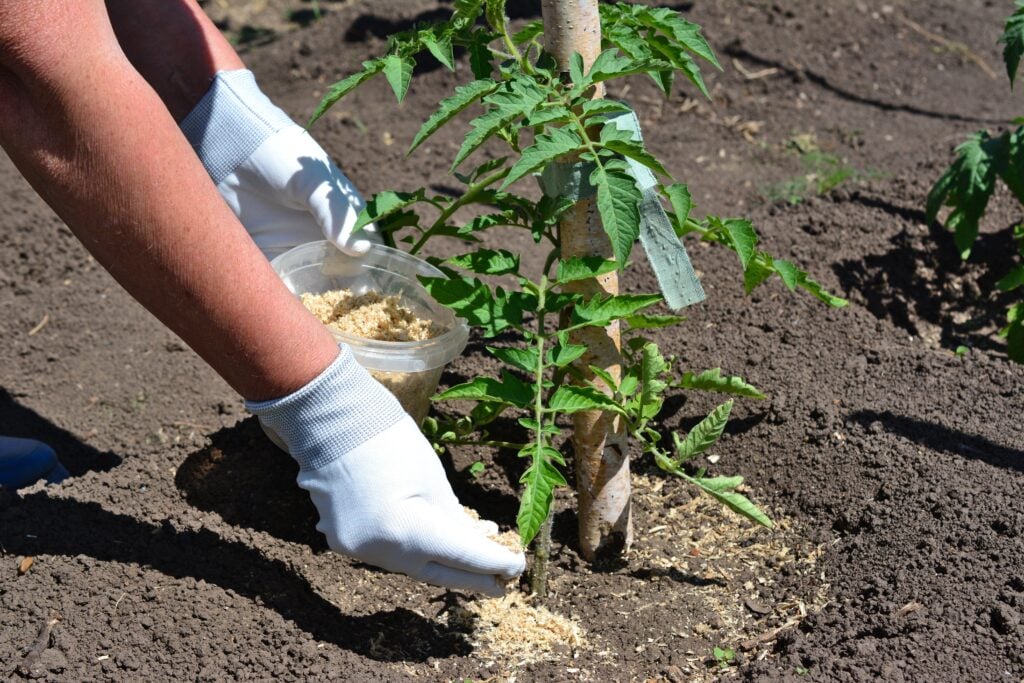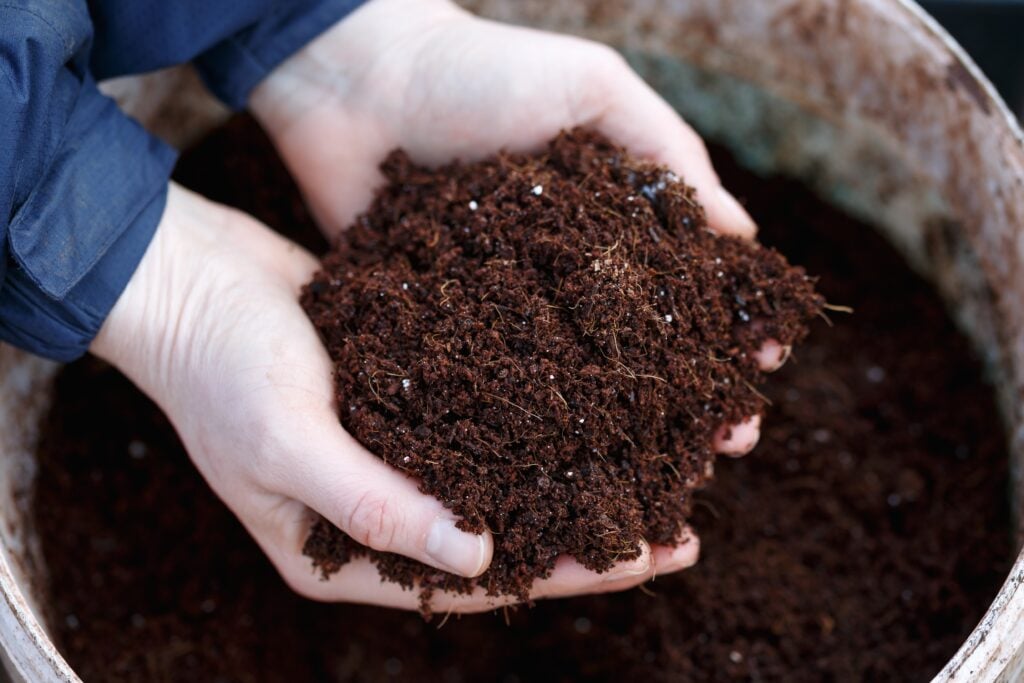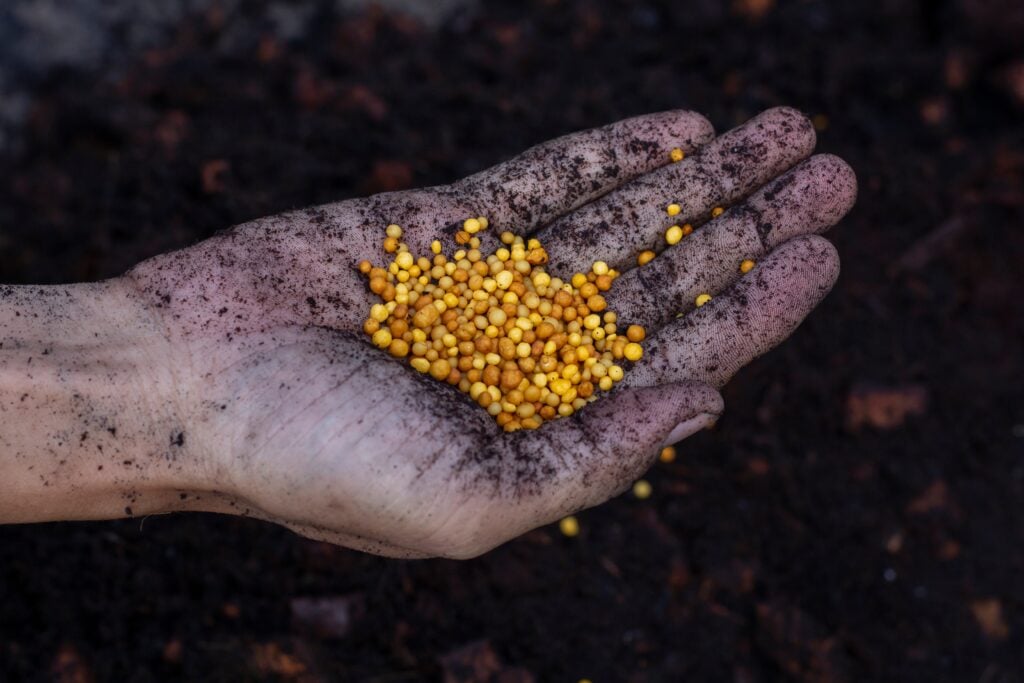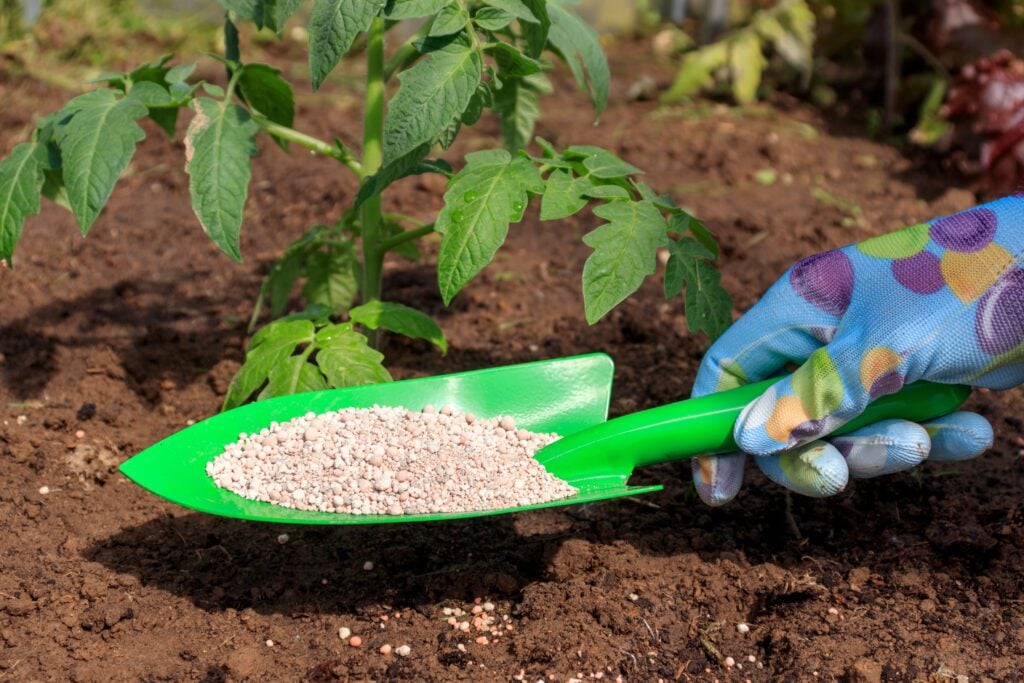One of the most critical activities a gardener can perform when growing tomatoes is providing the plant with the nutrients it needs through fertilizers. This gardening technique increases the success of harvesting a higher yield of tomatoes that look and taste great, regardless of where they are planted.

Numerous fertilizers can be applied depending on your tomato plant’s nutrient and micronutrient needs. This article will teach you the seven best tomato fertilizers without trying to sell you products like other sites. Not only that, but I’ve also compiled a list of the best NPK ratios for tomatoes that have helped me improve my fertilizing technique. And don’t skip my expert tips.
Table of contents
Complete Fertilizers
Complete fertilizers are the most common type of fertilizers gardeners use when growing tomatoes because of their versatility. These fertilizers contain a balanced blend of the three primary nutrients for plant growth, represented by N-P-K (Nitrogen-Phosphorous-Potassium), which is essential for heavy feeders like tomatoes.
Complete fertilizers will help tomato plants with:
- Robust branch growth
- Robust flower & fruit growth
- Immunity against pests and disease
Because of their versatility, these fertilizers can be used for general health promotion throughout different stages of the tomato plant’s life. These will provide gardeners with a simplified fertilization schedule to better equip their plants to handle disease, improve foliage, and control nutrient supply through different growth stages to prevent overfertilization.
Organic Fertilizers
Organic fertilizers come from natural sources and contain materials that provide critical nutrients for tomatoes. These are the top choices of gardeners who want an environmentally friendly and sustainable gardening process. They are safer for tomato-friendly insects like paper wasps and spiders, which help eliminate aphids, fruitworms, and tiny black bugs.
Organic fertilizers provide a mix of nutrients that will help tomato plants:
- Improve plant structure and stability
- Retain water
- Ward off disease and pest
In addition, they gradually release nutrients, which will help prevent common overfertilization burns. It should be noted that while some organic fertilizers have a well-balanced NPK ratio, most should be applied for a specific nutrient.

Below are some examples of organic fertilizers:
- Compost
- Compost is made of decomposed material from your kitchen, yard, and sometimes community. There are many materials to compost, including egg shells, banana peels, grass clippings, and twigs and branches.
- You should add this fertilizer to help increase drought resistance and improve water retention. Compost contains micronutrients like calcium, manganese, and sulfur that will also help improve the plant’s overall vegetative and flowering ability.
- Manure
- Manure is comprised of decomposed waste from cows, horses, chickens, goats, and other livestock.
- In addition to having a well-balanced NPK ratio to promote root development, robust flower growth, and increased disease resistance, it also contains the micronutrients copper, manganese, and zinc, which all help with more effective photosynthesis and development.
- Bone Meal
- This is made from the ground bones of animals and has a strong phosphorus composition.
- You should apply this fertilizer to your tomatoes to improve root development and flowering in the seedling and vegetative stages.
- Blood Meal
- This is comprised of dried blood, mostly from cows and other livestock.
- It is incredibly rich in nitrogen and should be added to tomatoes that require faster growth. Expect abundant, prosperous, leafy green growth and a quicker flowering process.
- Fish Emulsion
- Fish Emulsion comes in a liquid form and is made from the byproducts of fish.
- It is rich in nitrogen, calcium, and phosphorus and is one of the few fast-release organic fertilizers. It should be applied to tomatoes that need a quick nutrient boost if you notice your tomato plant is not growing or lacks flowers. It is also great for improving the skin strength of tomatoes.
- Seaweed and Kelp
- This fertilizer contains rich minerals like iron, calcium, potassium, and other growth-promoting hormones.
- They should be applied explicitly to tomatoes that need root development and to improve resistance to environmental factors like heat and droughts. It also dramatically impacts tomato skin strength.
- Green Manure
- This consists of cover crops like clover, winter wheat, alfalfa, and buckwheat that can be grown and tilled into the garden.
- It should be added to soil where tomatoes lack soil structure and nitrogen for quick vegetative growth.
- Rock Phosphate
- This is a natural source of phosphorous from the mineral phosphate and slowly releases its named nutrient. This is especially important for tomatoes in their early growth stages when they have high phosphorous needs for root development and flowering setting.
Granular Fertilizer
Granular fertilizer provides a slow-release and sustained amount of nutrients over an extended period in response to environmental factors like temperature and water. Several general benefits to tomato plants include minimal chance of nutrient leaching and longer-lasting nutrient benefits.
In addition, it will provide a mix of nutrients that will:
- Improve nutrient intake
- Encourage strong root development
- Increase robust leaf foliage and flowering
It provides a steady stream of nutrients, reduces the number of applications needed, and minimizes the environmental impact. The main micronutrients that will benefit tomatoes are nitrogen, iron, copper, and boron. These will help increase the photosynthesis process’s effectiveness and the tomato fruit’s shelf life.

Slow-release fertilizers come in the following forms:
- Coated Granules
- Semi-permeable and allow nutrients to be released slowly into the soil, decreasing the likelihood of nutrient burn for tomatoes.
- Polymer-Coated
- Thick coating that releases nutrients slower and longer than other tomato fertilizers. This is beneficial for tomato plants in nutrient-depleted soil.
- Sulfer-Coated
- Breaks down slower than other coatings and should be used when introducing more nutrients during specific growth stages.
- Isobutylidene Diurea
- Leverages microbial activity to break down the coating to release nutrients. This is a great option for those who want to minimize the environmental impacts of using a fertilizer.
Liquid Fertilizer
Liquid fertilizers provide a quick and efficient release of easily absorbed nutrients. Most of these options should be used as a complement to complete or slow-release fertilizers.
They will provide a mix of nutrients that will:
- Promote rapid vegetative growth
- Expedite flower growth
- Strengthen fruit skin
Some of the key benefits of using liquid fertilizers include:
- Quick nutrient intake is critical to promoting the fast growth of roots during the vegetative stage and fruit development.
- An immediate nutrient boost is beneficial if tomato plants are weak, stunted, or have nutrient deficiencies that must be addressed. This typically occurs during the flowering and fruiting stage.
- Precise control over the exact amount of nutrients being supplied. This customization will prevent overfertilization while targeting particular needs at specific times (down to the week).
- Enhanced micronutrient intake, allowing tomatoes to gain iron, manganese, zinc, and copper. This will help improve leafy green growth, stress resistance, root development, flower formation, and fruit skin development.
- Effective fertilizer for tomatoes growing in containers. According to Penn State University, ” Good tomatoes require a lot of nutrients. Most potting media comes with about a two-week fertilizer charge, then the plants need to be fed or growth starts to slow”. This means liquid or water-soluble fertilizer will be needed weekly to provide quicker and more frequent tomatoes in the garden.
Specialized Tomato Fertilizer
Specialized tomato fertilizers are formulated to meet the specific nutrient needs of plants during intentional times of each growth stage. Compared to other fertilizers, these are made specifically for tomatoes and address not only NPK, but secondary nutrients and micronutrients.
Several general benefits include:
- Higher Nitrogen ratio to promote robust root and branch development during the vegetative growth stage
- Enhanced phosphorus for more effective flower and fruit growth during the flowering and fruiting growth stage
- Increased potassium for better fruit quality during the fruiting growth stage

Being mostly slow-released, these can produce consistent growth and are suitable for foliar feeding or through irrigation. In addition, these fertilizers can be applied to target specific micronutrient needs of tomatoes. Some of the micronutrients that specialized tomatoes contain are:
- Iron
- This is crucial for chlorophyll synthesis and helps increase the effectiveness of photosynthesis. Apply iron if you notice your plants’ leaves are yellow.
- Manganese
- Another key micronutrient is needed to promote photosynthesis and activate different types of enzymes. Apply if you notice yellow or gold spots on early plant leaves.
- Zinc
- Is essential for the synthesis of growth hormones nucleic acid and to help promote the reproductive stages. Apply if the existing leaves are brittle with an orange or bronze color.
- Copper
- Involved in numerous enzymatic reactions that help to form lignin and improve nutrient intake. Apply if new leaves remained unrolled during growth or if existing leaf tips were necrotic.
- Boron
- It is vital in the development of cells and the transportation of sugars. Boron is a micronutrient that may be needed throughout all growth stages of the tomato plant. Apply if leaves remain small, curled, or have choleretic spots.
It should be noted that tomato plants require much less micronutrients than macronutrients. These nutrients are still vital to tomato plant success. They are usually needed when soil composition is incorrect, organic materials are unavailable in the soil, or other natural elements are absent.
Natural Minerals
Natural minerals should naturally be present in gardening soil. In some cases, there are deficiencies due to soil composition, pH levels, and other factors that require gardeners to add natural mineral supplements to their tomatoes.
Several benefits of natural minerals include:
- Increased plant vigor through the vegetative growth stage
- More effective water uptake
- Better fruit quality composition
Natural minerals will typically be applied less than macronutrients and at only very specific times of the tomato growth stage when nutrients are needed most. This will help target areas of deficiencies while preventing overfertilization.
Three important natural minerals (secondary nutrients) are:
- Calcium
- Important for cell creation and wall growth, fruit formation, and to help prevent blossom end rot.
- Sulfur
- A central component of amino acids, proteins, and vitamins that is essential for synthesizing compounds and helps promote an effective metabolism.
- Iron
- Critical for chlorophyll synthesis and overall plant nutrition. The appropriate time to apply this natural mineral is during the vegetative growth stage.
The video below gives the benefits of just one natural mineral, calcium, and how to organically apply it to your garden.
Water-Soluble Fertilizer
Water-soluble fertilizers are formulations that dissolve easily in water, making them one of the few fertilizers suitable for foliar and irrigation applications. They come in powder or granular form that easily dissolves in water, providing a quick and readily available supply of nutrients for fast absorption. These can provide macronutrients, secondary nutrients, and micronutrients to plants.
Several general benefits of water-soluble fertilizers include:
- Increased green foliage early in the tomato’s life
- Promotion of strong root development
- More effective water regulation
Other critical benefits include:
- Uniform nutrient distribution
- When properly mixed, this is one of the most effective fertilizers that distribute nutrients to all parts of the plant and will help prevent nutrient burn or toxicities from too much fertilizer.
- Precision nutrient control
- Unlike slow-release fertilizers that work over long periods, this type will allow you to control what nutrients you provide and when. This is critical for addressing specific needs at specific stages and can quickly help a deficient tomato plant.
- Quick response to nutrient deficiencies
- If your tomato plant is nutrient deficient, sick, or weakened, this is the quickest fertilizer and most effective way to address its needs immediately.
Expert Tip
The most crucial expert tip for understanding the best tomato fertilizers is to start with soil testing. Understanding your soil’s existing nutrient profile is critical because it informs you about what your plants have already received and what they need.
Proper soil testing will guide you in selecting the best fertilizer for each growth stage and nutrient need of your tomatoes. It helps avoid both under-application and over-application of nutrients, which can determine the success of your gardening season. By understanding your soil’s NPK baseline, you can use a fertilizer that fits within your budget, meets your tomato needs, and can even be environmentally friendly.
While fertilizer is important, it solely depends on the findings of an initial soil test that determine what is needed during the various growth stages. This will allow you to apply the best tomato fertilizer at the correct time.
Frequently Asked Questions
Yes. If created properly, homemade fertilizers are a great way to provide nitrogen, phosphorous, potassium, and other nutrients. It is highly recommended to create homemade fertilizers through traditional composting methods.
No. While there will always be subtleties of NPK ratios for different tomato plants, hobbyist gardeners do not have to worry about different types of NPK ratios for different types of tomatoes.
No. You can use any of the listed fertilizers in this article when growing tomatoes in containers. Liquid fertilizers are the most commonly used, but testing your potting soil to determine nutrient needs before any application is recommended.
Learn More About Tomatoes
While providing the best tomato fertilizer is just one gardening technique for providing a higher yield of quality tomatoes, you can check out my other articles below to help make this the best gardening season ever!

Take Away
Understanding the significance of the different types of tomato fertilizers is critical to the plant’s overall health and ultimately provides quality fruit. The plant will almost always grow strongly and quickly by providing the best tomato fertilizer in each stage. It will also have abundant flowers, providing quality and tasty fruit.